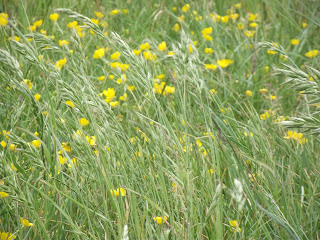My masterplan is to keep you updated on what's happening in this established meadow. It'll be interesting to compare and contrast it with our Meadowmat test plots.
In the last 60 years, over 90% of our traditionally managed wild flower meadows have been lost. Victims of changes in society. Meadows and other agricultural land have been buried beneath housing developments, roads, and retail parks and a rising population demanding more and better food has meant that farmers have had to change the way they do things - ploughing up meadows to grow crops and managing grazing land so that it produces the maximum amount of animal feed.
By contrast, a traditionally managed meadow recieves no chemical fertisers or herbicides and, although it may not offer high yields of hay or support large numbers of dairy cattle on a small area, it does hark back to a more peaceful way of life.
17.4.2011
Here are some of the pictures I took last week on the traditionally managed meadow. There are no cattle grazing on it at the moment and the wild flowers are thriving. Cowslips and daisys are blooming and the buttercup leaves are clearly visible.
 |
| plenty of native species crammed into a small area. Can anybody identify any of these plants? |
 |
| while the cows are away - Rosie can play |
 |
| cowslips and daisys bloom amongst the grasses . |
Walked past the traditionally managed meadow just the other day. Rosie, Lola and I were out for a quick walk, there was not time to dally and take photos, but what I did notice was that the meadow was a lot more colourful that it was just 10 days ago. The cowslips were in full bloom, as were the dandelions and the daisys.
But what struck me more than the colour, or even the scent, was the sound. Approaching the meadow along the track, I became aware of a gentle humming noise that got louder as I got closer to the gate. Alongside the meadow and for the whole of the length of it, the dogs and I were treated to an audible drone - bees. Lots and lots of bees all busying themselves gathering nectar from the many flowers. And dancing through the hedge and out onto the drove - butterflies. Orange-tipped butterflies, little blue ones, brown speckledy ones and yellow brimstones. That's another thing to add to my "todo" list - learn to identify butterflies.
In contrast, on the opposite side of the track to this beautiful wild flower meadow is a wheat field. I have to say, that despite the drought, the wheat is looking really well and it promises to yield enough corn to make a good few boxes of weetabix. But in terms of insect life, well, lets just say it wasn't nearly as noisy.
May 2011. Pictures paint a thousand words
 |
| Meadow Buttercups thrive among the grasses |
 |
| The first red clover I've seen this year |
 |
| Hawkbit, from a distance these looked just like buttercups |
 |
| Grass flowers are beautiful too |